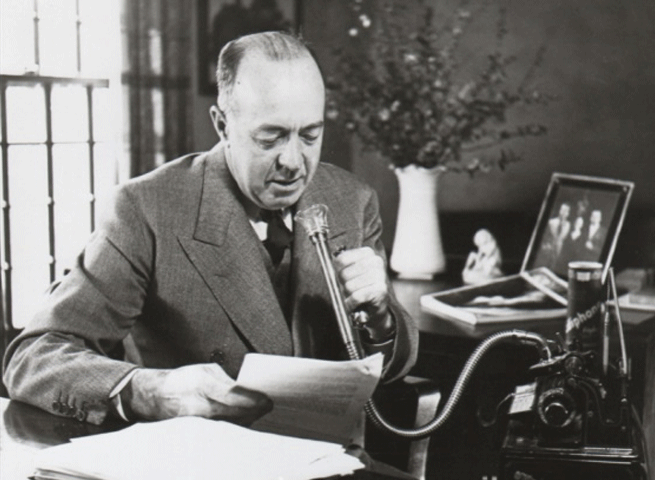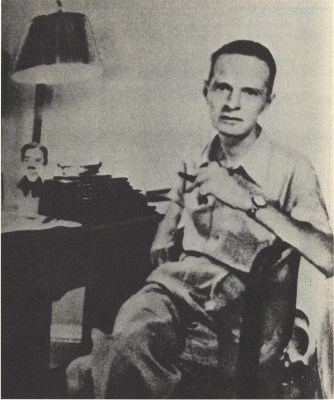Edgar Rice Burroughs Dictated His Work — So I Tried It
 Over his nearly forty-year career, Edgar Rice Burroughs put into use every writing method available to him. In a letter to the Thomas A. Edison Company regarding their Ediphone machine, which ERB purchased in 1922, he wrote: “I have written longhand and had my work copied by a typist; I have typed my manuscripts personally; I have dictated them to a secretary; and I have used the Ediphone.” (He didn’t mention in the letter that he also used the Dictaphone, Edison’s competitor.) Although Burroughs would shift his writing methods over the decade and sometimes returned to the trusty typewriter — even letting a ghostly force take over the typing duties in the prologue to Beyond the Farthest Star — wax cylinder dictation machines became his preferred tool. In his daily log of writing progress, he’d describe his workload in terms of how many wax cylinders he’d gone through that day. “May 24 Dictated 5 cyl. today — something over 4000 words.”
Over his nearly forty-year career, Edgar Rice Burroughs put into use every writing method available to him. In a letter to the Thomas A. Edison Company regarding their Ediphone machine, which ERB purchased in 1922, he wrote: “I have written longhand and had my work copied by a typist; I have typed my manuscripts personally; I have dictated them to a secretary; and I have used the Ediphone.” (He didn’t mention in the letter that he also used the Dictaphone, Edison’s competitor.) Although Burroughs would shift his writing methods over the decade and sometimes returned to the trusty typewriter — even letting a ghostly force take over the typing duties in the prologue to Beyond the Farthest Star — wax cylinder dictation machines became his preferred tool. In his daily log of writing progress, he’d describe his workload in terms of how many wax cylinders he’d gone through that day. “May 24 Dictated 5 cyl. today — something over 4000 words.”
In the letter to the Edison Company, Burroughs listed the reasons he preferred to work using dictation machines: “Voice writing makes fewer demands upon the energy … it eliminates the eyestrain … the greatest advantage lies in the speed. I can easily double my output.” He kept his Ediphone (or Dictaphone) near his bedside “to record those fleeting inspirations that would otherwise be lost forever.”
At the time, dictation machines were primarily used for businesses. In order to make the most out of one, a writer had to have a stenographer to transcribe the wax cylinder recordings, so dictation machines weren’t much use to pulp fiction writers. But Edgar Rice Burroughs was both a writer and a business. He was wealthy enough to have an office staff, including a secretary whose job was to type up the manuscript from ERB’s cylinder output. The secretary would also do the job of shaving each wax cylinder — this required its own machine — so it could be reused.
Today, dictation software is available to anybody who has a smart phone, and some fiction writers have discovered they enjoy those same benefits of voice writing Burroughs loved, particularly the boost in output. When you see a self-help writing book with a title like You Can Write Over 5,000 Words in an Hour, it’s probably advocating dictation software. (Seriously, five thousand words an hour means typing at a consistent 83 words per minute without stopping. I’m a trained touch-typist and I can only hit 80 wpm for about five minutes at a stretch, and that’s when I’m copying something already written out.)
Although I’ve known about the possibility of using dictation for years, I never would have taken steps to actually use it in my writing if it were not for Edgar Rice Burroughs. If one of my favorite authors swore by the triumphant power of the spoken voice as a method for creating his wildly imaginative worlds, why not give it a shot? I’m not a sluggard when it comes to writing speed — I can usually knock out 2,500 words in an hour — but trying a new tool could open up possibilities. At the worst, I’d get a sense of what Burroughs’s routine was. Walk a mile in his shoes, dictate a few cylinders with his machine (or something like it).
I hunted for dictation software and apps that I could work with. Since purchasing a Chromebook four years ago, I’ve migrated most of my writing to Google Docs, so I started out with the Voice Typing feature that’s already part of Docs. The transcription was smooth, but Voice Typing didn’t have some important punctuation features I need. Next, I downloaded the Dragon Anywhere mobile app from Nuance, which appears to be the industry standard when it comes to voice recognition software.

Whatever else I feel about the usefulness of dictation in my writing, Dragon Anywhere is impressive with how well it turns speech into text. It makes few errors and has a deep well of commands to make editing easy and increase the potential to shift into complete hands-free operation. I know if I were unable to use my hands to type, I’d shell out whatever Nuance wanted for the best Dragon dictation software. (It isn’t cheap. The Dragon Anywhere mobile app has a free one-week trial, but after that it’s $15 a month or $150 for a year. The desktop software can run from $100 to $400.)
After a week of working with both Google Voice Type and Dragon Anywhere (i.e. before the free trial was up) over prolonged sessions, I decided dictation wasn’t for me. Although I was able to achieve the magical goal of writing over 5,000 words with Dragon Anywhere once I got used to it, the error rate was so high that I spent half an hour fixing major transcription glitches. These weren’t standard first draft mistakes, but utter gibberish that I wouldn’t be able to decipher unless I corrected them with the ideas still fresh in my head. That extra half hour of untangling transcription errors counts against the speed. Realistically, I don’t feel I’d made a significant improvement in output.
Two other factors about dictation didn’t click. First, what I’d written didn’t sound like the “authorial me.” Choppy short sentences, too much rambling, an excess repetition of words. My first drafts are never high quality, of course, but these drafts were bad in a way that made me want to delete them all and start over — typing this time. Second, I actually love typing. The eyestrain, the energy issues that Burroughs mentions, I don’t feel any of that. I connect so much to my writing through the keyboard that typing feels more like my voice, my writer’s voice, than my speaking voice.
This links to another of my favorite authors, Cornell Woolrich. Woolrich’s writing methods and attitude toward the tools of the trade are the opposite to Burroughs. I don’t know if Woolrich ever attempted using a dictation machine — he probably couldn’t afford one — but he loved the act of typing with literal passion. How literal? He dedicated his novel The Bride Wore Black to the Remington portable typewriter he used for most of his life. (He also dedicated Phantom Lady to his hotel room. Woolrich was a lonely, reclusive man.) In his unfinished autobiography, The Blues of a Lifetime, Woolrich describes the feeling of connection he felt with his typewriter:
A life-long partnership, a fellowship, a combine, of flesh and of thin steel casing, of fingertips and of keys, of mind and of agilely-responsive mechanism: lower case that turned to upper at a tap, upper that turned back to lower at another tap; asterisks, apostrophes, parentheses, quotation-marks, single quotation-marks to go within the double, hyphens and colons and commas, that flashed up like sparks, and like sparks dimmed again, left behind in the onrush …
And into this transformer, this reagent, went streams of thought and dramatic highspots and narrative stretches printed invisibly on the retina of the mind, and out of it they came printed visibly now in black type on white paper, in order that they could be conveyed to others, and taken in again to the retinas of other minds.
This almost Cronenbergian mixture of man and machine with sexual undertones is a bit of an extreme way of describing the excitement of writing fiction via typing. But Woolrich wrote murder scenes like they were sex scenes, so there’s that. But I understand this sensation of feeling hardwired into a writing mechanism. Perhaps I’ve been wired into typing for so long that changing to another method makes the spirit of the writing feel “off.” Ah well, no regrets … and I think my word count comes out about the same. Burroughs and Woolrich were both prolific and successful authors. It’s not the typewriter’s fault that Woolrich never enjoyed any of his success.
Ryan Harvey is one of the original bloggers for Black Gate, starting in 2008. He received the Writers of the Future Award for his short story “An Acolyte of Black Spires,” and his stories “The Sorrowless Thief” and “Stand at Dubun-Geb” are available in Black Gate online fiction. A further Ahn-Tarqa adventure, “Farewell to Tyrn”, is available as an e-book. His most recent publication, “The Invasion Will Be Alphabetized,” is now on sale in Stupendous Stories #19. Ryan lives in Costa Mesa, California where he works as a marketing writer. Occasionally, people ask him to talk about Edgar Rice Burroughs or Godzilla in interviews.
And now I am sad that (I assume) none of Burroughs’ original wax cylinders exist and are available for listening.
Though it obviously worked for Burroughs and some others, I can’t imagine doing any kind of serious writing this way. It would be like trying to build a brick wall while wearing a blindfold.
Erle Stanley Gardner, the poster boy for prolific writer, dictated his stories for much of his latter career.
Fascinating. I tried Dragon Naturally Speaking 9 some years back to transcribe stuff I’d hand-written. I’m a visual writer and not sure I could switch over. But maybe I’ll try again….
I like writing my vomit drafts with dictation and this reminds me of the story of the Howard Hawks Method for screenwriting by voice recording. Screenwriters still use the technique. It’s sometimes called the http://www.TalkingDraft.com